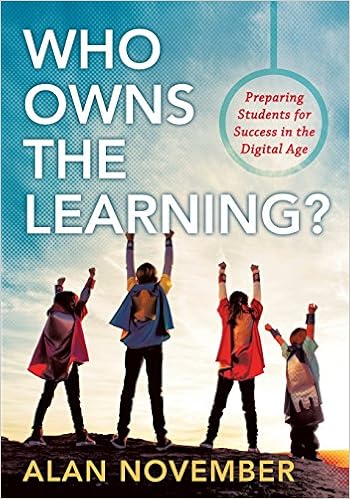The title of Who Owns the Learning came up as a possibility for this past summer’s #langchat, and the title immediately caught my eye. It’s been a huge dilemma in my quest to figure out why students don’t continue in their language journey – if they don’t own the learning past my classroom, have we all wasted our time? Maybe yes.
See it on Goodreads * on Amazon * on November’s site * on The Incidental Techie
November organizes this easy-to-read, short book around four jobs students can do in the classroom to begin taking ownership of their own learning.
1. Tutorial designer
November uses the magnificent example of Mathtrain.tv to showcase the student job of tutorial designer. Middle school math teacher Eric Marcos has built a website for students around the world to use as they learn math concepts, and all the tutorials on the site are designed by his own students. Why? Because as many kids say in the chapter, you don’t really know it until you can teach it.
2. Student Scribe
Another math teacher, Darren Kuropatwa, has instituted the job of student scribe, in which one student takes detailed notes and posts them to the class blog for everyone else to download and use. I made this job a part of my classroom this semester and it was sort of successful. Several students would come in asking to be the Story Scribe, the person designated to draw our story. The rest could draw it if they wanted or just listen and watch. I copied and scanned the Scribe’s drawing and passed it out the following week, as well as uploading it to our Edmodo folder. The problem was on my end: after that, I never did anything with these drawings, so I’m not sure why we did them to begin with. If I continue having anyone draw the story, I’ll stick with the scribe idea, but we’ll put them to use in some way: questions or a re-tell the next week, maybe. I used to ask follow-up questions one or two days later that made these drawings very useful, but in my once-a-week format now I’m still trying to figure out if they have any use.
3. Student researcher

November proposes another idea for a student job that I can’t emphasize enough: teaching students to research their own questions. This chapter was full of tips for using Google that I was not aware of, such as how to restrict the search to reliable websites, and something I haven’t employed enough, restricting results to a particular date range. There is so much information out there. We can’t let students loose to find anything anywhere and we can’t tell them they can’t trust what they see on the internet; we have to teach them how to evaluate and mine for the best information.
Coincidentally, this week I caught a post by Free Technology for Teachers, “Five Strategies to Help Students Conduct Better Informational Searches.” Check it out.
4. Global Communicator and Collaborator (of course, Silvia Tolisano

Of course, for the topic of helping students communicate and collaborate globally, November went to the work of Silvia Rosenthal Tolisano, of langwitches.org, and her colleagues. After interacting with Silvia via Twitter for quite some time, it was great to meet Silvia at our Kentucky World Language Association annual conference in… 2013, maybe?
This chapter speaks directly to what we’re doing as world language educators:
We need to start teaching our students global empathy by developing their ability to understand and appreciate other points of view.
Finally, November concludes with a chapter encouraging teachers to join forces with other educators, and shows how teachers in the previous four chapters have done just that. Why all this emphasis on collaboration? My big takeaway from the book is the answer to that question:
To put it plainly: give students a real audience, and they will do real work.
I credit this quick read as the major inspiration behind my foray into project-based language learning this year, a combination of collaborating with other teachers, communicating globally, and turning students into product designers. Check out our early efforts on 48horasen.com and see if your Spanish class would like to join us in showing off our cities for the Spanish-speaking world.
What professional book(s) impacted your journey this year?
2 Comments
Comments are closed.





[…] my students to learn more by themselves without getting overwhelmed. Sara-Elizabeth as always has encouraged me to pick up another […]
[…] Maybe it started when I first assigned the job of Story Scribe. Well, of course I should. Alan November told me to have a scribe. Teachers following Ben Slavic’s and Bryce Hedstrom’s expert guidance were also […]